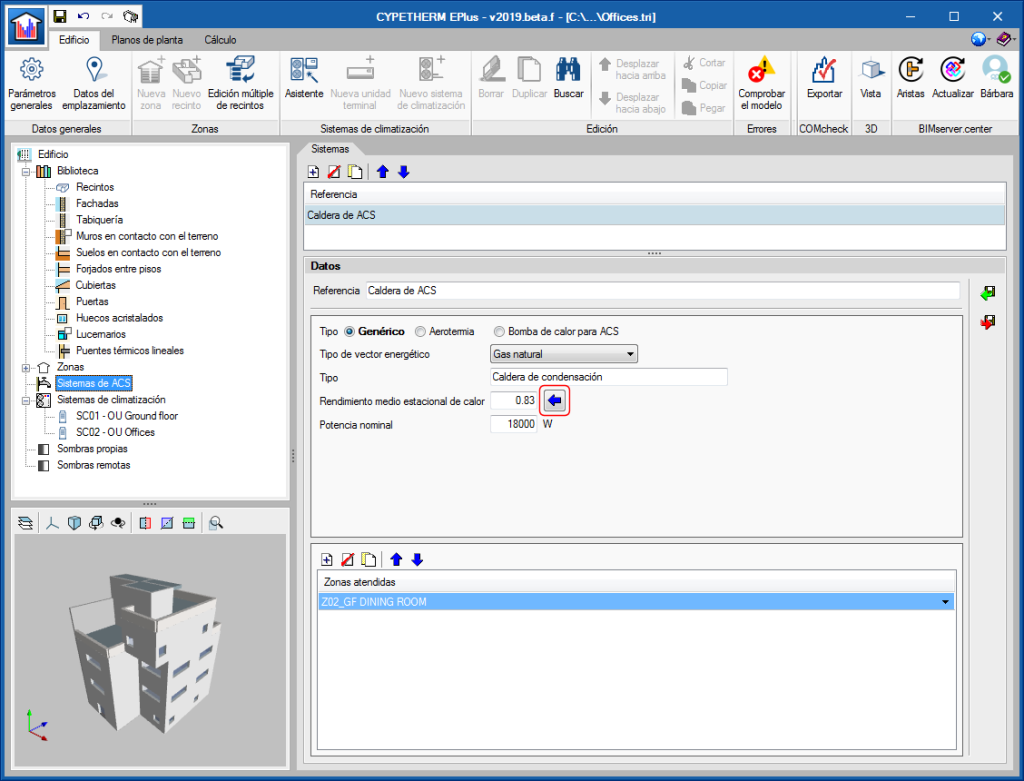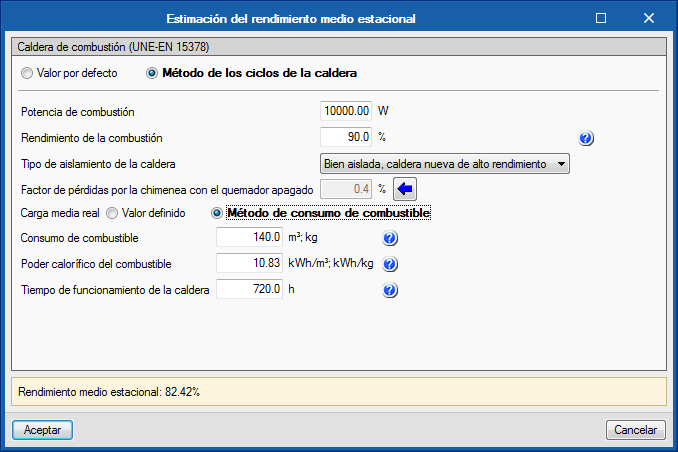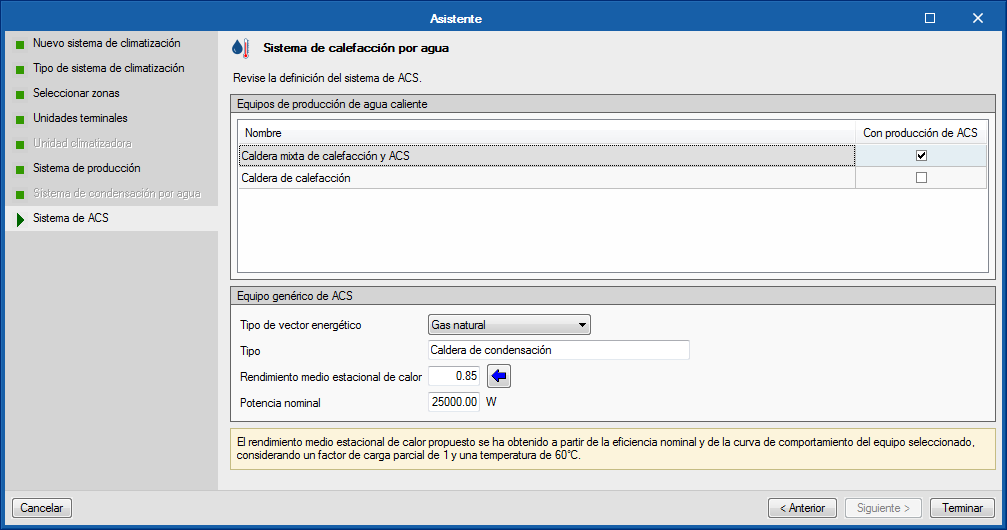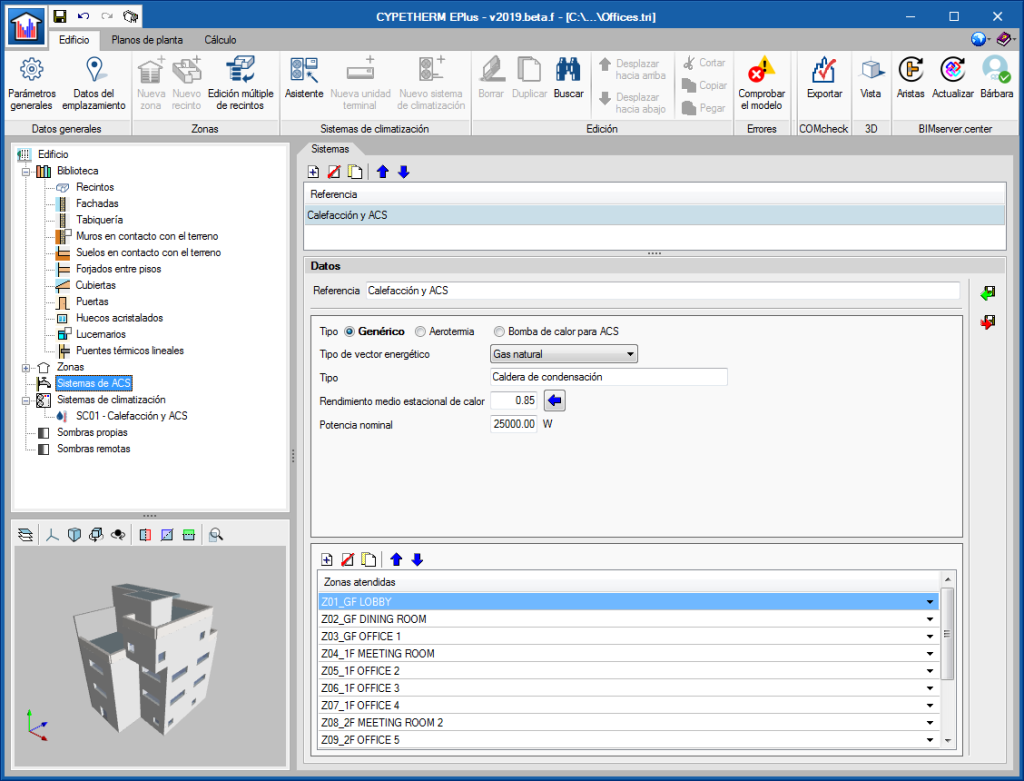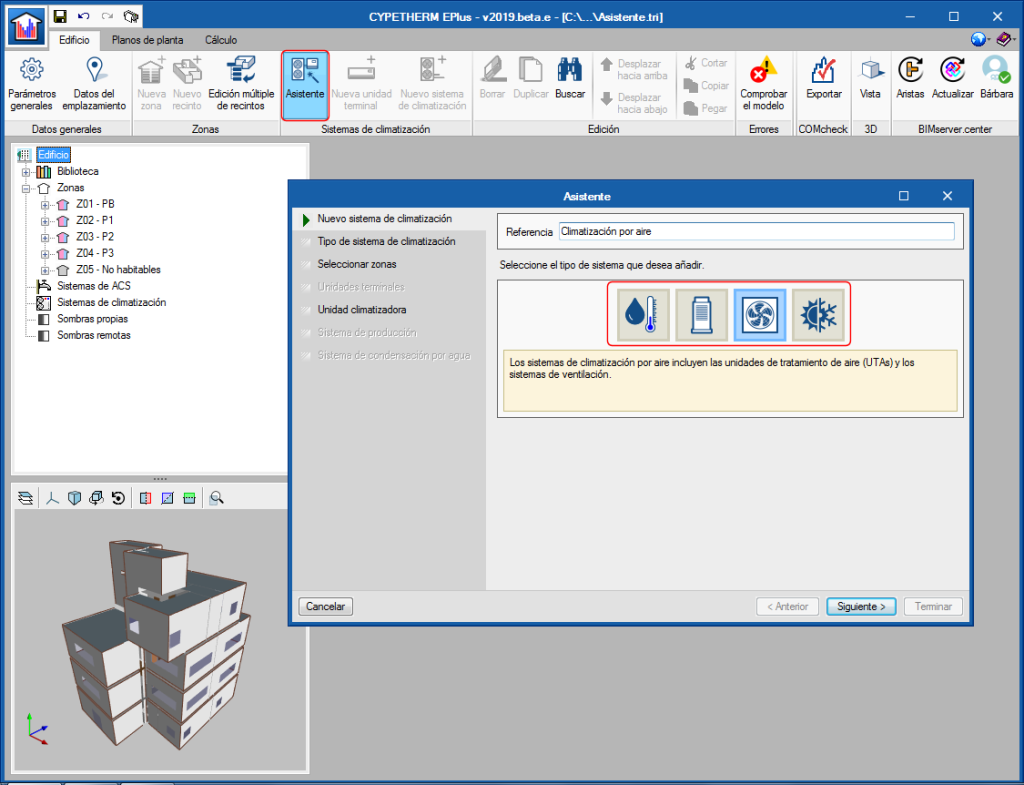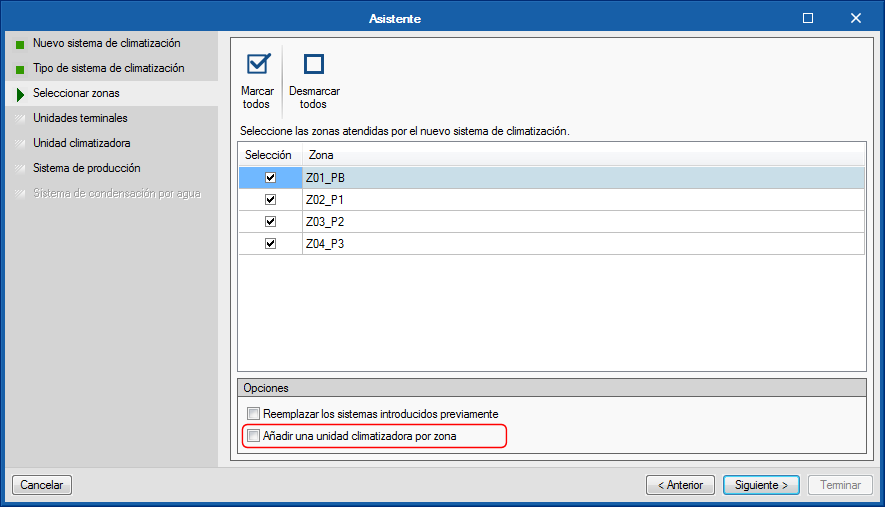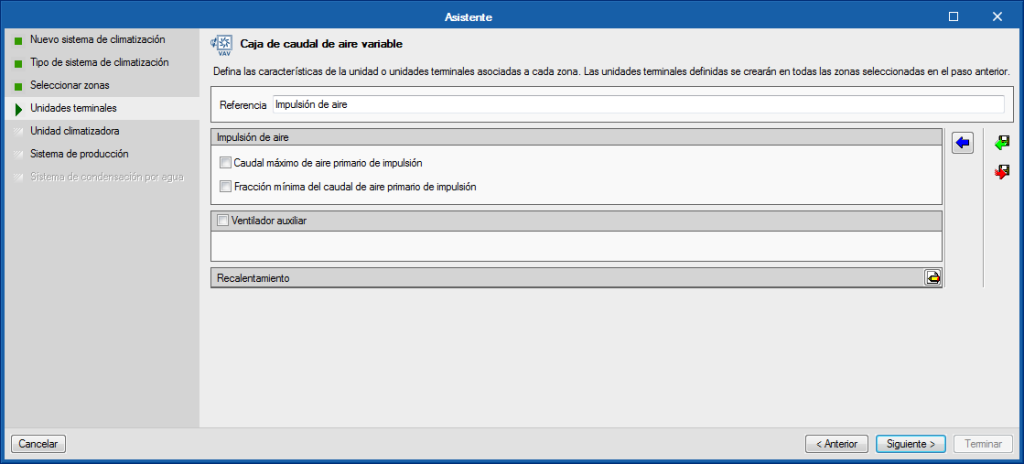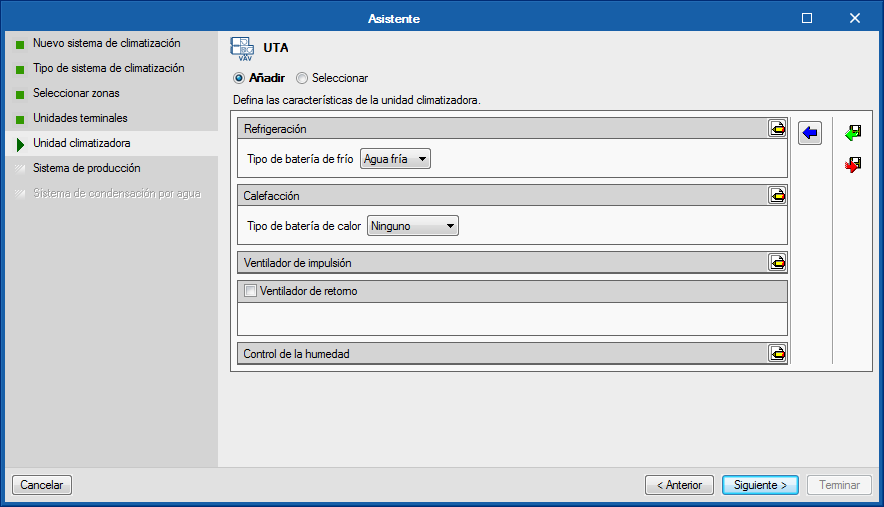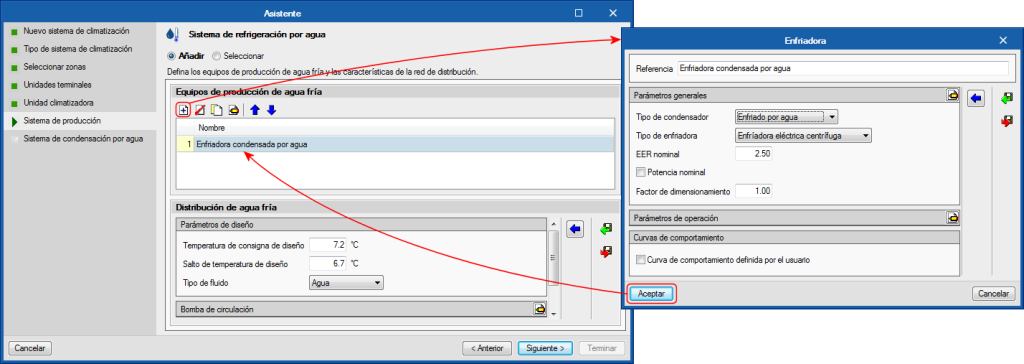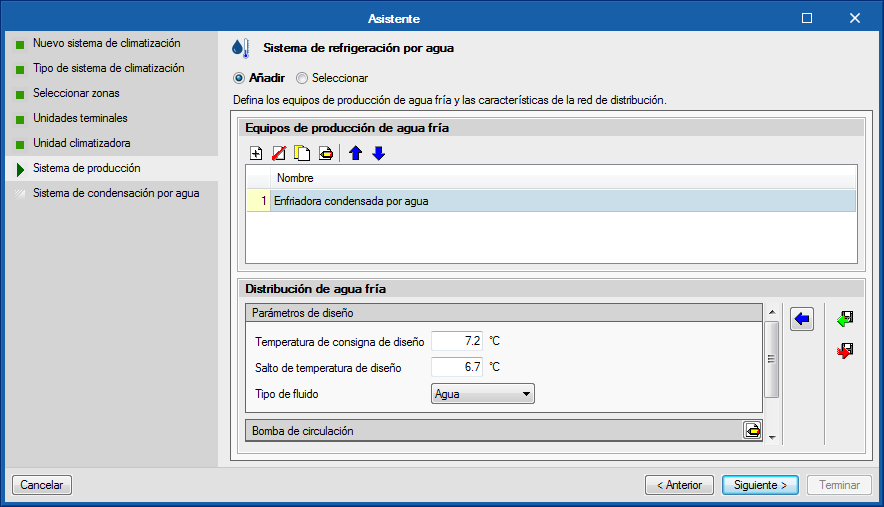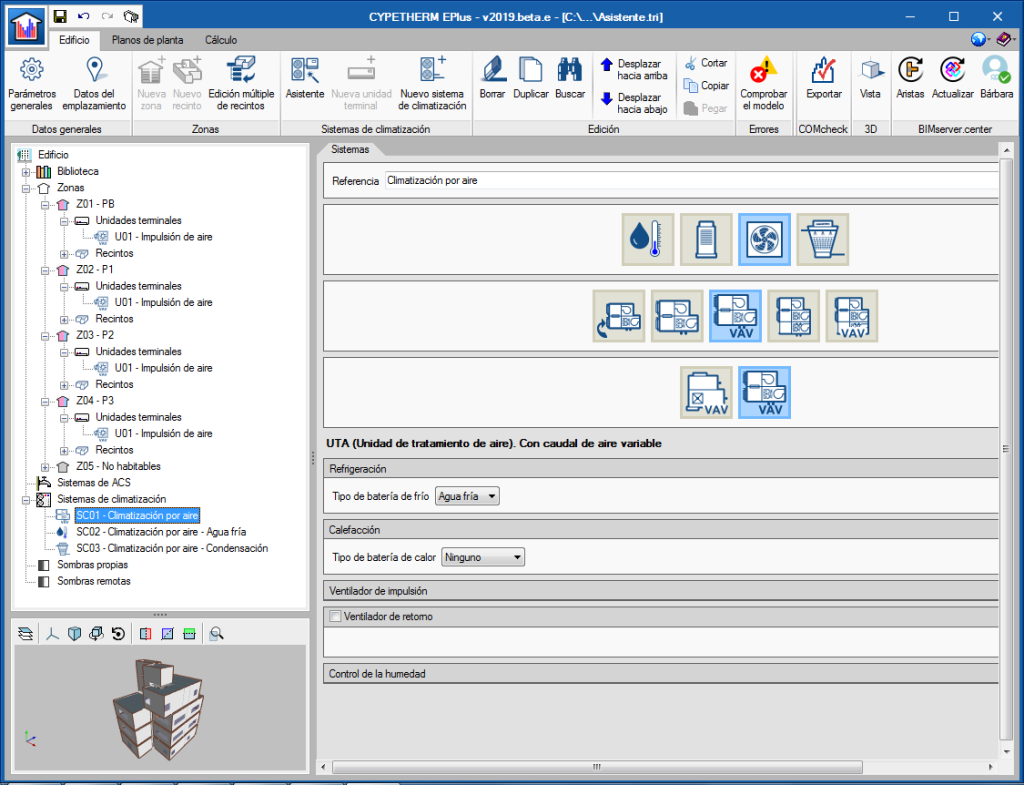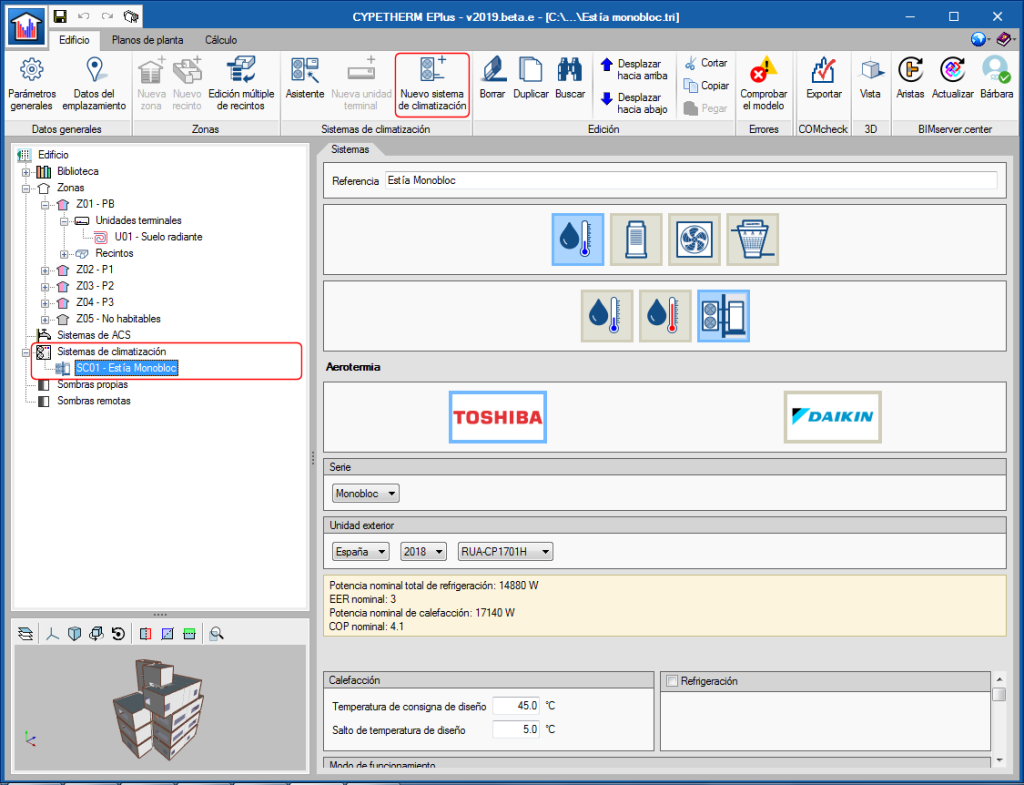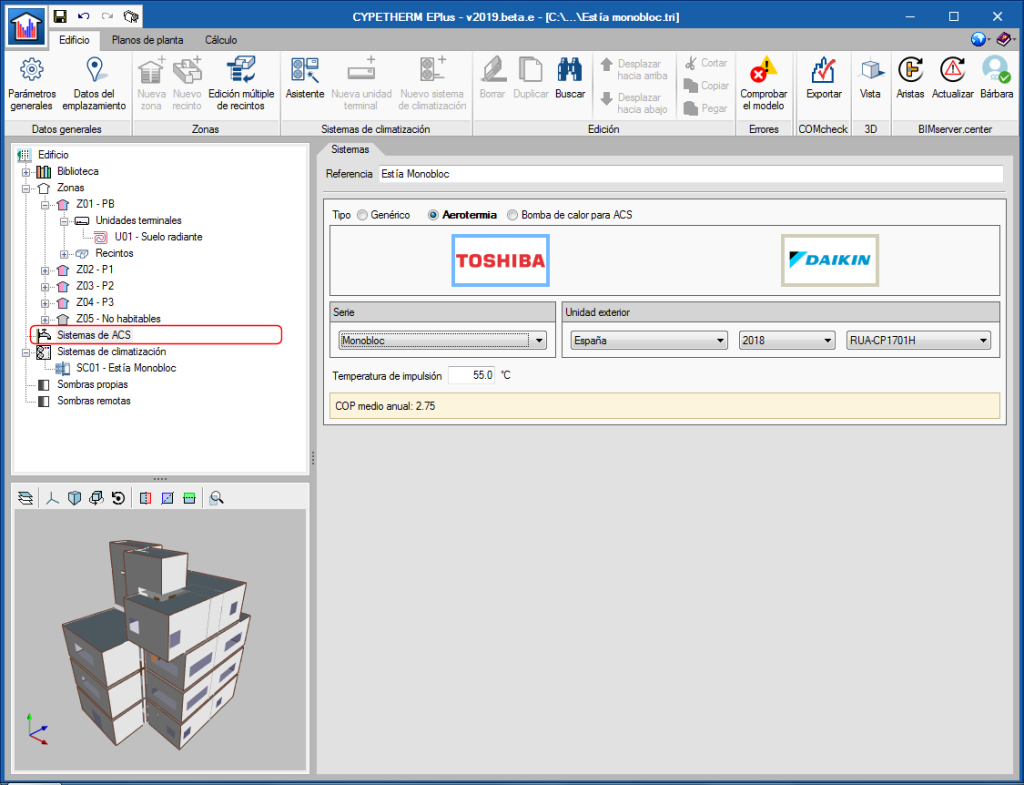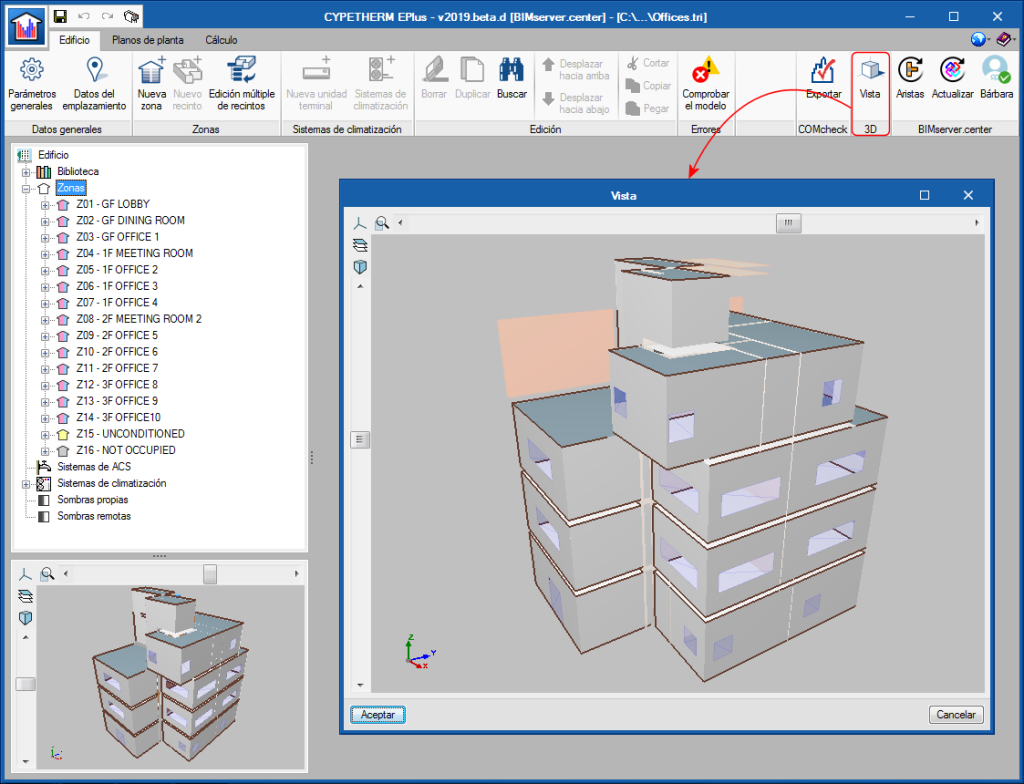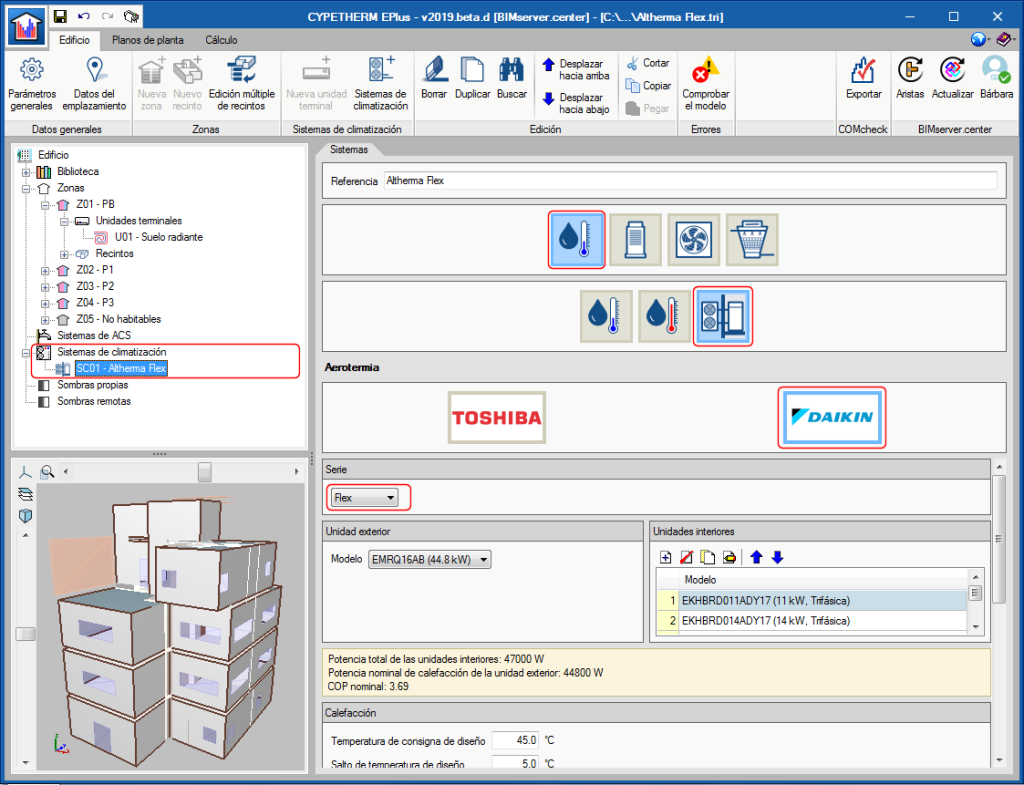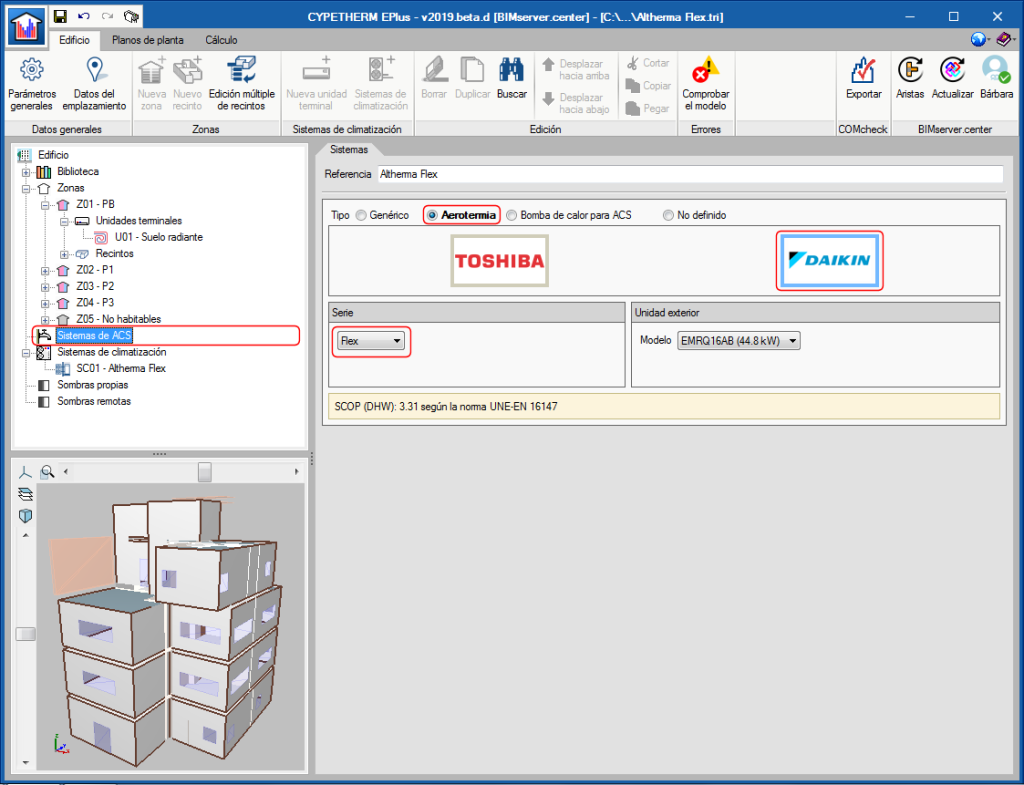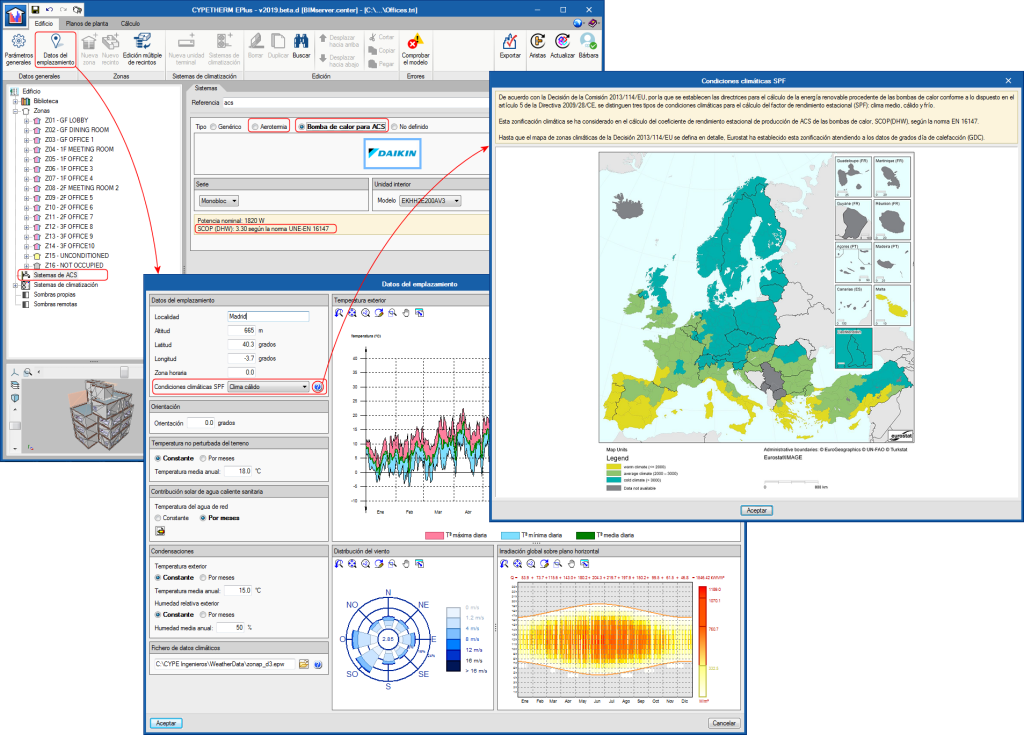An assistant has been added in generic DHW systems to calculate and import the value of the average seasonal performance of combustion boilers according to the UNE-EN 15378 standard. Two of the methodologies included in the standard have been implemented. On one hand, users can choose a value of the average seasonal performance by default, which depends on the fuel, age and type of boiler (Table B.3 UNE-EN 15378). On the other hand, the boiler cycle method (Annex N UNE-EN 15378), can be chosen, which provides a more accurate estimate if technical and equipment consumption data is available.
Update history
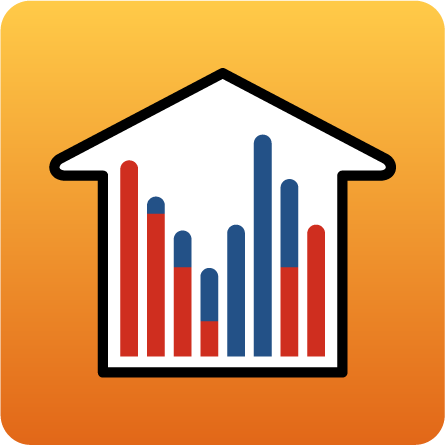
CYPETHERM EPlus
Estimate of the average seasonal performance of boilers for DHW production
- Published on
- 2019.f
Definition of mixed equipment for heating and DHW using an assistant
The "Assistant for the definition of air conditioning systems" includes the "With the production of DHW" option for hot water generation equipment and systems.
When this option is activated, the step: “DHW system” appears in thein the index sequence of the assistant. Upon reaching this step, the assistant shows the operating characteristics for DHW production of the previously defined hot water production equipment. In the case of water heating systems, the user must choose a boiler that will produce the DHW. The properties of the panel are recalculated automatically.
Users can edit the values proposed by the assistant if he has more precise data, and even use the new assistant to calculate the average seasonal boiler performance (blue arrow icon). At the end of the assistant sequence, an ACS system with the characteristics of the defined equipment will be created automatically.
The configuration of the DHW system that has been created by the assistant depends on the option that has been selected previously in the "Daily DHW Demand" in the “General Parameters”. If "Total demand of the building" has been selected, a single DHW system will be created that supplies the entire building, regardless of the number of production systems that have been created with the assistant. On the other hand, if "Demand by zones" has been selected, a DHW system will be created that serves the same zones as the defined air conditioning system using how water. With this option activated, if the option "Add a production system by zone" is selected in the assistant, the corresponding ACS system by zone will be created.
- Published on
- 2019.f
Reduction in the analysis duration
Improvements have been implemented in the simplification of the 3D thermal model, which entail a significant reduction in the time required to analyse the project. As in previous versions, the simulation with the simplified building is carried outby choosing the "Simplification of the vertical partitions" options within the design options.
- Published on
- 2019.f
64-bit Version
As of the 2019.f version, CYPE programs (those downloaded from our website and those downloaded from the BIMserver.center platform) are compiled for 64-bit systems. The 64-bit compilation of CYPE software implies the use of the superior features of 64-bit processors and operating systems compared to those of 32 bits.
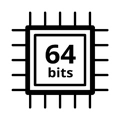
Please bear in mind that you must have a 64-bit operating system to be able to work with any 64-bit software.
In any case and as a temporary measure, the 2019.f version is available in 64 and 32 bits on the download area of our webpage. The programs that can be downloaded from the BIMserver.center platform are only available in 64 bits. If you have a 64-bit operating system, you can work with either the 64-bit and 32-bit version of our software, although we strongly recommend that you install the 64-bit CYPE software version.
You can see which operating system is installed on your computer by clicking on "Control panel > System".
Since 64-bit microprocessors began to be massively introduced into personal computers from 2003 and from the Windows XP version, Microsoft already offers the two versions of its operating systems (32 and 64 bits). We understand that almost all our users will have computers with 64-bit processors (x64) and 64-bit operating systems.
It could occur that a user may wish to work with a computer with a 64-bit processor but with a 32-bit operating system. It would be very strange if the computer had a 32-bit processor (x86 - computers over 15 years old). If any of these is your case, we advise you to talk to your hardware or software provider to update your situation as soon as possible. However, you can download the 32-bit version and work with CYPE programs that can be downloaded from our website until your situation is up-to-date.
- AcouBAT by CYPE, Arquimedes, CYPE 3D, CYPE Accessibility, CYPE Cost Estimator, CYPE Gas Supply, CYPE Sewerage, CYPE Water Supply, CYPECAD, CYPEFIRE FDS, CYPEFIRE Hydraulic Systems, CYPEHVAC Radiant Floor, CYPEHVAC Schematics, CYPELEC, CYPELEC Electrical Mechanisms, CYPELEC MULTILINE, CYPELEC Networks, CYPELEC PV Systems, CYPELUX, CYPEPLUMBING, CYPESOUND, CYPETEL Wireless, CYPETHERM BRIDGES, CYPETHERM EPlus, CYPETHERM HYGRO, CYPETHERM LOADS, CYPEURBAN, IFC Builder, Open BIM Model Checker, Open BIM Switchboard, Plugin Open BIM - Revit, Portal frame generator, Punching shear verification, StruBIM Deep Beams, StruBIM Embedded Walls
- Published on
- 2019.f
Update to version 9.0 of the EnergyPlus™ analysis engine
The 2019.e version of CYPETHERM programs with the EnergyPlusTM analysis engine uses version 9.0 of the engine, published on 10th October 2018.
- Published on
- 2019.e
Import “Open BIM TOSHIBA” equipment
CYPETHERM programs with the EnergyPlus™ analysis engine, CYPETHERM EPlus and CYPETHERM RECS Plus, can import the equipment and pipes introduced in "Open BIM TOSHIBA" (implemented in this version) if they are connected to the BIM project located on the BIMserver platform.
- Published on
- 2019.e
Export to “CYPETHERM Improvements Plus”
As of the 2019.e version, CYPETHERM programs with the EnergyPlus™ analysis engine, CYPETHERM EPlus and CYPETHERM RECS Plus, export the results of the simulation, with the "Improvement measure" option, via the Open BIM workflow to "CYPETHERM Improvements Plus" (implemented in this version). Therefore, they no longer export the results of the simulation to CYPETHERM Improvements.
- Published on
- 2019.e
Assistant to define air conditioning systems

A new tool has been implemented to define the air conditioning systems of the building in a step-by-step way. Using the "Assistant" button, users can create a new complete air conditioning system, or add new terminal units to systems that are already defined in the project. This tool improves the ergonomics of the program, by allowing terminal units to be added and deleted in a single step in the different thermal zones of the building.
When the “Assistant” button of the "Climate control systems" section of the top menu of the program is selected, the window in which the name of the new system is to be provided appears. Users must also choose its typology amongst the water, direct expansion, air or constant performance system categories.
To the left of this window, users can see the steps which the assistant will guide him through to complete the definition of the air conditioning system. The different sections are displayed in black if they must be defined in accordance with the selected options. The buttons on the lower bar allow users to navigate in the assistant.
In the second step of the assistant, users must choose the type of air conditioning system, in accordance with the category chosen previously.
In the third step, users must select the areas of the building that will be associated with the air conditioning system. The assistant will automatically create the terminal units of the system defined in each of the selected zones. By default, all these terminal units will be connected to a single production system or to a single air conditioning unit in the case of air conditioning systems. On the other hand, if the option "Add an air conditioning unit per zone" is chosen, the terminal units created in each zone will be connected to their respective system.
The following steps of the assistant run through the different elements that make up the type of air conditioning system that has been chosen, so users can define its properties. In general, the panels corresponding to the terminal units and air conditioning systems that are available in the program will be shown, as they are required.
In the images, a variable air flow system has been defined that contains an air conditioning unit with a cold water battery connected to a water-cooled chiller. The assistant successively displays the panels to define the variable flow type box terminal units, the variable flow ATU, the water cooling system the chiller contains and finally, the water condensing system for the chiller. At the end of the wizard, the new elements of the air conditioning system will appear in the diagram of the main screen.
- Published on
- 2019.e
Toshiba EstiaMonobloc aerothermal system
The EstiaMonobloc system, a new system in the 2018 Toshiba catalogue, has been added in the Toshiba aerothermal water-air conditioning systems and in the aerothermal DHW systems.
In the aerothermal air conditioning systems, below the Toshiba logo, users can choose amongst the different outdoor units of the Monobloc series. This equipment must be connected to water-air conditioning terminal units.
If users wish to use an EstiaMonobloc system for air conditioning and DHW, the same outdoor unit model must be selected in both sections (as occurs with the other aerothermal equipment).
- Published on
- 2019.e
3D view to complete screen
The "3D View" button has been added in the toolbar of the "Building" tab. Users can view, in a new window and in full screen, the 3D view of the BIM model of the building.
From previous versions, the 3D view of the BIM model is also shown in the lower left corner of the screen although it cannot be extended to full screen. The configuration of both 3D views (perspective, elements that are displayed, display mode ...) is independent.
- Published on
- 2019.d
Daikin Altherma Flex aerothermal system
The 2019.d version includes Daikin's "Altherma Flex" range in "Aerothermal-type water-conditioning systems" and "Aerotermal-type DHW systems". The equipment of this range only produce hot water, for heating and/or DHW.
In "Aerothermal-type air conditioning systems", users can choose amongst different indoor and outdoor unit models of the Flex series. This range allows for several indoor units to be connected to a single outdoor unit, as long as the total power of the indoor units lies between 50% and 130% of the power of the outdoor unit.
The Altherma Flex aerothermal equipment must be connected to radiator-type or radiant-floor water conditioning terminal units.
The Altherma Flex range is also available within "Aerothermal-type DHW systems". As with the rest of the aerothermal equipment, if users wish to use an Altherma Flex unit for heating and DHW, the same outdoor unit model must be selected in both sections.
- Published on
- 2019.d
Weather conditions to calculate the SPF of the heat pumps (Improvement of the analysis model of Daikin hot water systems)
In the “Location data” panel, it is possible to select the climatic conditions to calculate the seasonal performance factor (SPF) of the heat pumps, in accordance with Commission Decision 2013/114 / EU, which applies Article 5 of the European Directive 2009/28/EC. According to the EN 16147 standard, these climatic conditions are also applicable when calculating the seasonal coefficient of performance of heat pumps for DHW production “SCOP (DHW)".
Daikin has supplied this coefficient, providing CYPETHERM EPlus with an improved design model of Daikin's DHW systems (aerothermal and heat pump for DHW) by distinguishing between these climate conditions to determine the corresponding value of "SCOP (DHW)" according to the EN 16147 standard.
CYPETHERM RECS Plus also includes this improvement. Although it does not include the possibility of selecting the SPF climate conditions (since Portugal only has warm weather according to Commission Decision 2013/114/EU), the "SCOP (DHW)" value of Daikin's DHW systems (aerothermal and heat pumps for DHW) of CYPETHERM RECS Plus, corresponds to the warm climate zone.
- Published on
- 2019.d


